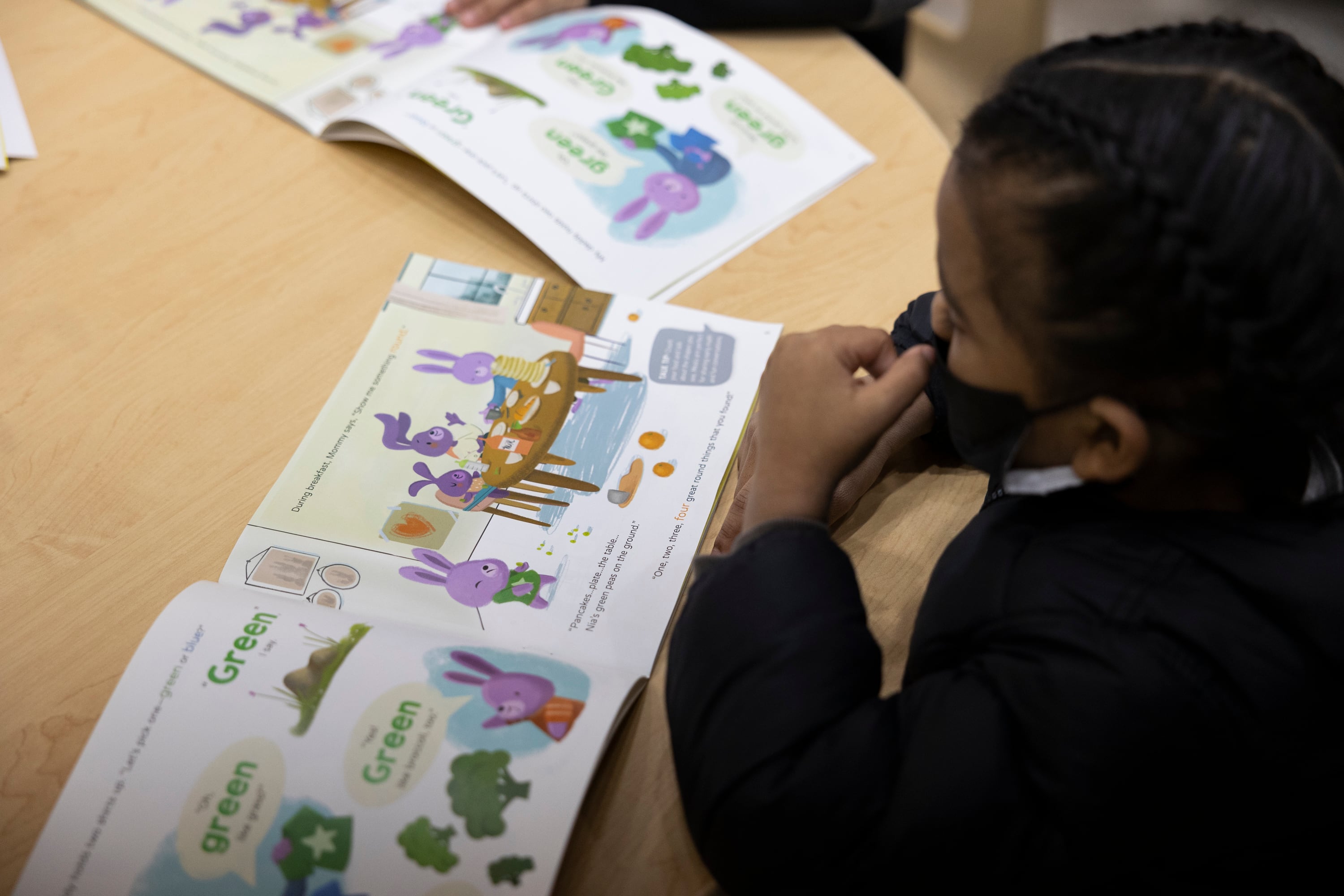Sign up for Chalkbeat Philadelphia’s free newsletter to keep up with the city’s public school system.
The Philadelphia school district’s demanding new English language arts curriculum is getting mixed reviews from teachers.
One of their major complaints is that they must spend a lot of time making sure they can use provided materials in their lessons. They also say there is not enough class time to help lagging readers, and that they haven’t been adequately trained to teach the new curriculum.
At the same time, teachers do not dispute its emphasis on the science of reading, which is now generally accepted as the best method for literacy instruction. There are also indications that teachers are seeing students engage better with reading materials and demonstrate stronger literacy skills.
The new curriculum is part of an ambitious instructional overhaul the district launched last year, when it spent $70 million in pandemic aid on new math, English language arts, and science materials. About $25 million went to the new reading curriculum from EL Education, including Expeditionary Learning for grades K-8 and Study Sync for 9-12. Officials hope this helps students improve on sobering academic outcomes: On last year’s state exams, only about 34% of Philadelphia’s students in grades 3-8 scored proficient in reading.
The curriculum shift also represents the latest chapter in a long-running tug of war in Philadelphia between the value of imposing a regimented, standardized curriculum, and the power of giving teachers leeway to be creative and innovative.
But as with any big initiative in school districts, the devil is in the details.
“It tells you to use [certain] cards or pictures, but they aren’t provided,” said Shelly McKeown, a second grade teacher at the Lowell Elementary School in Olney. “You have to make tons of copies and cut things out yourself.”
Worse, she said, in her school, there aren’t enough books for all the students: “There are only five or six copies of each text.” That means several students share a single book — not great for encouraging emerging readers.
Aly Boyd, a literacy specialist at McCall Elementary School in Queen Village, said she favors the science of reading, which requires systematic instruction in phonics and phonemic awareness as well as promoting fluency, vocabulary, and comprehension.
But while some of the curriculum makes sense, Boyd said, “overall it’s not cohesive. The tools are not aligned to the objectives. I wish I knew why.”
Many teachers, she said, “are scrambling” to prepare and to cover everything in the time provided, especially when they are facing children with skill levels all over the map.
“You always go back to teacher knowledge as the best tool as long as they know the content area,” Boyd said. “But I don’t think this curriculum makes it easy for teachers to learn.”
In a statement responding to questions from Chalkbeat about the new English curriculum, district spokesperson Monique Braxton said the district has “been thoughtful in providing support” to teachers.
She cited 12 paid — albeit optional — professional development sessions in the spring, an optional summer institute on the science of reading, and additional “mandatory and voluntary” sessions since the school year started.
In addition, she said, the district provides coaches and learning specialists to help teachers.
While the EL Education curriculum is grounded in the science of reading, “texts are more complex than teachers are used to, and the amount of content within each lesson is very dense. It can be a steep learning curve,” said Laura Boyce, the executive director of Teach Plus PA, a teacher advocacy group that supports lessons based on the science of reading.
The teachers’ guide for the curriculum, Boyce noted, is well over 100 pages long for a six-week unit.
New curriculum represents latest pendulum swing for teachers
Through much of the 2010s, teachers could choose from several different programs for reading instruction, Boyce said.
But a 2020 study by the Council for Great City Schools found that district curriculums did not “put enough emphasis on foundational skills in the early grades,” among other deficiencies. About three years ago, city teachers created a homegrown reading curriculum. While some people liked this “by Philly, for Philly” approach, it was never formally evaluated for quality, Boyce said.
When the district adopted the slate of new instructional materials last year, Superintendent Tony Watlington warned people not to expect that the EL Education curriculum would lead to instant improvement. But he did tout its emphasis on the science of reading, and district officials said they had done their research.
“Before we decided on this, we engaged stakeholders, teachers, community members, and asked what they were looking for,” said Dr. Nyshawama Francis-Thompson, the district’s chief of curriculum and instruction, in an interview.
In contrast to the era when Philadelphia teachers often took the lead on choosing or developing curriculum, Mary Williams, a professor of education at La Salle University, said via email that she has heard from teachers that the lessons are too scripted.
“This program is not going to be successful unless the teachers get some flexibility in how it is implemented and get more professional development support and coaching,” she wrote.
The Philadelphia Federation of Teachers went so far as to conduct a recent survey of teachers on the curriculum, and presented a rundown of the most common complaints to district officials.
Some 800 teachers responded. Among the top concerns were too little time to cover the material, not enough training, and insufficient tools to help students who fall behind, said PFT President Arthur Steinberg.
“We saw there was some unrest with it, people weren’t happy, so we wanted to nip it in the bud and get more information from as many members as we could,” Steinberg said.
The union wants to help create a response to teachers’ concerns “so people in Harrisburg don’t call us failing anymore,” Steinberg said, referring to legislators who decide how much state education aid to send to Philadelphia and other districts. (The PFT has not shared detailed results from the survey publicly.)
State lawmakers are making their own push to get more Pennsylvania school districts to change how they teach reading.
Earlier this month, the Senate adopted a bill passed previously by the House that encourages districts to adopt curriculums based on the science of reading, although it doesn’t mandate them to do so and doesn’t provide corresponding funding.
It would authorize the Pennsylvania Department of Education to create a state literacy council that would develop lists of acceptable curricula, and help schools assess students’ reading skills, among other things.
“This gives kids a fighting chance,” said Rep. Ed Neilson, a Democrat from Northeast Philadelphia, during a House debate on the bill. “My son got lucky to learn how to read. This bill will help kids like mine.”
Boyce said advocates will push Gov. Josh Shapiro to include $100 million in his proposed budget for next year dedicated to this initiative.
Curriculum gets good reviews for older grades, student engagement
For all the issues with the new curriculum, some teachers say their students are benefiting.
“My students are more engaged, they are able to answer comprehension questions more easily, they have a bigger vocabulary in their speech,” said Kristyn Kahalehoe, a kindergarten teacher at John Hancock, a K-5 school in the Far Northeast.
While the rollout hasn’t been perfect, she said her students “are able to answer questions about the text” while also having “a higher retention of letter names and sounds.”
At a seminar last month at Drexel University on the science of reading, first grade teacher Kinu Aneja told attendees that she thought the new curriculum was “strong” due to its emphasis on phonics and because it dictates the need “to meet students where they are.”
But with sometimes as many as 30 students in the class at varying stages of development, she said a teacher can nevertheless get “overwhelmed.”
And the district hasn’t necessarily provided everything teachers might want to use with the new curriculum.
For instance, it includes a “tools challenge” in which students learn about tools and also work on their motor skills. Among the tools needed are spatulas, eyedroppers, and tweezers. But the district did not provide those things, expecting that teachers would bring them from home.
District spokeswoman Christina Clark did say that part of the curriculum is “supplemental” and not mandatory.
Kahalehoe said her students are doing well with the new curriculum but acknowledged that she may have it easier than those in higher grades. “I wouldn’t have the same perspective as a seventh grade teacher,” she said.
Aly, the reading specialist at McCall, said she considered the curriculum to be much stronger in the higher grades than in the lower ones, when phonics is most important.
The new curriculum does not provide a second grade teacher easy access to kindergarten-level phonics tools, for example, that could be useful for students still at that stage of development.
For help, teachers could “click around online,” she said. But that, she said, “is very time consuming. … It’s frustrating.”
Aneja, who spoke at the Drexel forum, is in her fourth year teaching in the district, and her third at Bache-Martin Elementary School in Fairmount. In a subsequent interview, she stressed that kids come to classrooms from different backgrounds and at different academic levels. Adapting to the new curriculum is a “hard adjustment,” she said.
“The big takeaway is that in theory the curriculum makes sense, but it requires a lot of prep and studying on the teachers’ part and right now that’s hard to implement,” Aneja said.
Still, Aneja has high hopes the new curriculum will ultimately benefit students.
“At the end of the year, we’ll be able to see a fuller picture,” she said.
Dale Mezzacappa is a senior writer for Chalkbeat Philadelphia, where she covers K-12 schools and early childhood education in Philadelphia. Contact Dale at dmezzacappa@chalkbeat.org.






